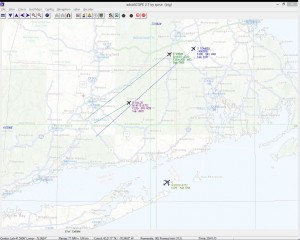RTL-SDR
I just picked up a Realtek based DVB-T (European) TV tuner for use as a wide band general coverage receiver of radio stations thanks to the awesomeness of software defined radio.
So far, I’ve been using SDR# for standard radio listening (so far tested successful listening of FM Stereo transmissions (local standard radio stations), a local 2 meter ham radio repeater (at least the ident transponder), CB radio, and some local business band radios.

SDR# also comes with an ADS-B decoder for listening to and decoding the public transponder transmissions from commercial aircraft which include GPS data, registration information, and flight plan number information (all of which can be looked up online to see more information), but the coolest part is there’s another application called ADSBScope which will take that data and plot the vectors for the transponders the radio is actually listening to, in effect giving you a transponder “radar” view of where all the planes are in the area, and their flight information.
I’m just sitting here marveling at what can be done with a software driven USB wide-coverage receiver dongle that cost me $15 shipped and a bunch of free software.
I’m sure I’ll have more to come (maybe I’ll build some guides to how I got it all set up). I’ll certainly be posting as I learn more about various radio modes, how to find and analyse different signals, and any other fun I find along the way. I think my biggest obstacles with this hardware setup are:
- front end selectivity / gain control / filtering / rejection. When I experimented with picking up the signals from my CB handheld I found that even at only 4 watts, being in the same room with the antenna completely over-drove the inputs to the point where no amount of filtering or gain control that I tried (please note that I’m particularly inexperienced) did any good (though I don’t discount that I very easily could have been doing it wrong).
- Dinky antenna. it came with a ~7″ mag-mount antenna with an MCX connector and about 3′ of cable, which means that everything I’ve done has been inside, and fairly close to a computer (which tend to be a bit RF noisy). I suspect that with a proper wide-band receive antenna, I should get better quality signals that I can work a bit better with.
- My own inexperience. This is certainly a huge experience booster. I really don’t know that much about the basis of radio technology (I’m learning), and how it all applies. I’m still learning what all these knobs, switches, buttons, and dials do, and for the most part, I make it worse instead of better, but I’m learning.
